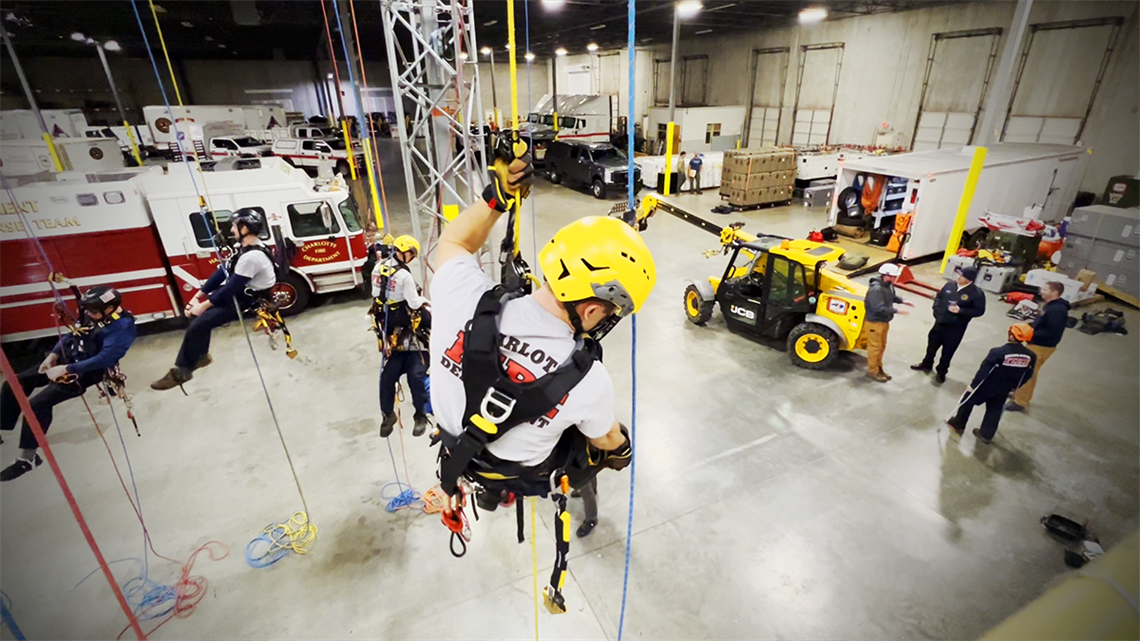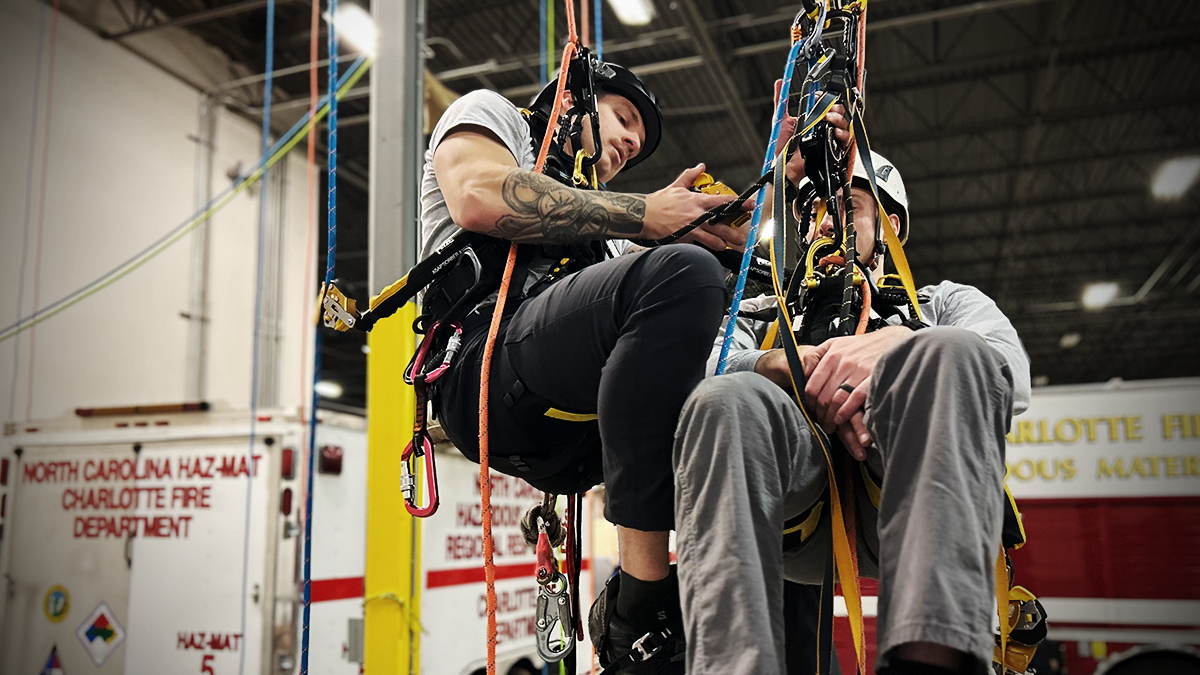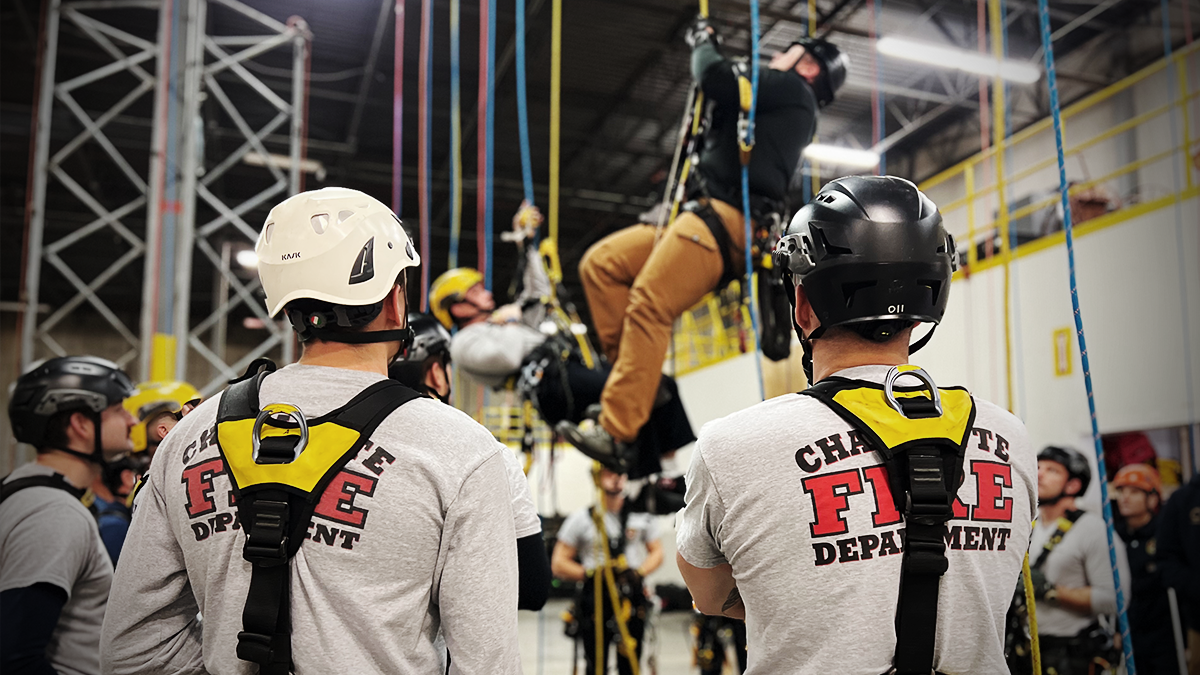Charlotte Fire Training Reaches New Heights
Published on January 22, 2025

Firefighters maneuver through an advanced rope system inside the Charlotte Fire Special Operations Complex, sharpening their life-saving rescue techniques.
By Kevin Campbell, Charlotte Fire
Whether it’s rescuing someone stranded high above the city or responding to a life-threatening emergency in a hard-to-reach space, Charlotte Fire is ready. This week, firefighters trained for these demanding scenarios during an intensive four-day SPRAT course at the Charlotte Fire Special Operations Complex, showcasing the department’s commitment to tackling any challenge.
The training, which stands for the Society of Professional Rope Access Technicians, has become a cornerstone of Charlotte Fire’s mission to serve as an all-hazards resource for residents and visitors. While initially developed for industrial applications, such as rescuing window washers or stage riggers, the course has been adapted to meet the department’s needs.

Firefighter Mulligan demonstrates rope access precision while securing an anchor, ensuring safety and reliability during high-angle rescues.
"This course is part of what makes Charlotte Fire unique," said Fire Chief Reginald Johnson. "Our commitment to all-hazards readiness ensures that when the community calls, we respond with the right tools, training, and mindset to save lives, no matter the situation."
The SPRAT program began five years ago with a handful of Charlotte firefighters receiving initial certifications. Since then, it has grown into a vital training component, tailored specifically to the unique challenges faced by the department. Firefighter Clayton Llewellyn, one of the course instructors, explained its origins and evolution.

Firefighter Clayton Llewellyn guides a trainee through a critical maneuver, emphasizing the importance of safety and deliberate actions in high-angle rescue situations.
“A few of us were part of the initial group to complete these courses and earn certification,” Llewellyn said. “Since then, we’ve worked hard to develop a program that not only meets the high standards of SPRAT but also equips Charlotte Fire with specialized skills tailored to the unique challenges we face in our community.”
Firefighters McClure and Yerrick carefully observe a demonstration of advanced rope rescue techniques, preparing to apply these critical skills in real-world scenarios.
These skills are diverse and versatile. From rescuing workers suspended by ropes to aiding those trapped in areas unreachable by ladders, the training provides solutions for a variety of scenarios.
“We teach them to set anchors, ascend ropes, and safely transition someone onto our rescue systems,” Llewellyn said. “Whether it’s a tree worker stuck in a canopy or a technician on a crane, these skills make all the difference.”

Firefighters Spencer William and Clayton Johnston focus intently during their rope rescue training, building the skills needed to handle high-stakes situations with confidence and teamwork.
Charlotte Fire has expanded the training to include firefighters from ladder companies, not just dedicated rescue teams. This ensures that a wider range of personnel can effectively handle emergencies involving height or confined spaces.
“This training builds confidence for those who don’t regularly operate in these conditions,” Llewellyn said. “It’s a foundational skill set that makes our entire department more versatile and efficient.”
Participants came from diverse backgrounds and levels of experience, from seasoned firefighters with decades on the job to newer recruits. Llewellyn noted that the course starts everyone at the same level.

Firefighters collaborate during rope rescue training, focusing on coordination and technique to master the skills needed for challenging high-angle rescues.
“Most participants haven’t done this type of work before,” he said. “By the end, they’ve learned something entirely new and leave with a foundation they can build upon in their careers.”
The SPRAT course goes beyond teaching rescue techniques—it emphasizes deliberate decision-making and safety.

A firefighter carefully adjusts a rope system while demonstrating key techniques to a fellow participant, emphasizing precision and safety during the hands-on training session.
“This training stands apart from most fire courses,” Llewellyn said. “It’s highly advanced and demands precision, focus, and deliberate actions. When you’re on the rope, you’re often operating solo, which means every decision and movement has critical consequences.”
The demanding nature of the training left some participants sore and tired, but the feedback was overwhelmingly positive.

Firefighter Clayton Llewellyn demonstrates advanced rope rescue techniques while students observe and prepare to apply the skills during their training.
“They come in not knowing what to expect, and they leave feeling empowered,” Llewellyn said. “Our goal is to lay a foundation for them to become even better than us. That’s how we grow as a department.”
As Charlotte grows, so do the complexities of emergencies faced by its fire department. Programs like this ensure Charlotte Fire remains prepared for anything, whether it’s a medical emergency at great height, a worker trapped in an industrial site, or an unusual rescue scenario requiring creative solutions.
“Our firefighters’ dedication to constant improvement is what keeps Charlotte Fire at the forefront of emergency services,” Chief Johnson said. “This training is one more way we’re ensuring the safety of our community.”
Through innovative training and a relentless commitment to excellence, Charlotte Fire continues to demonstrate why it is one of the most versatile and capable fire departments in the nation.

Firefighters engage in practical exercises during the SPRAT course, building the confidence and skills required for advanced rescues.